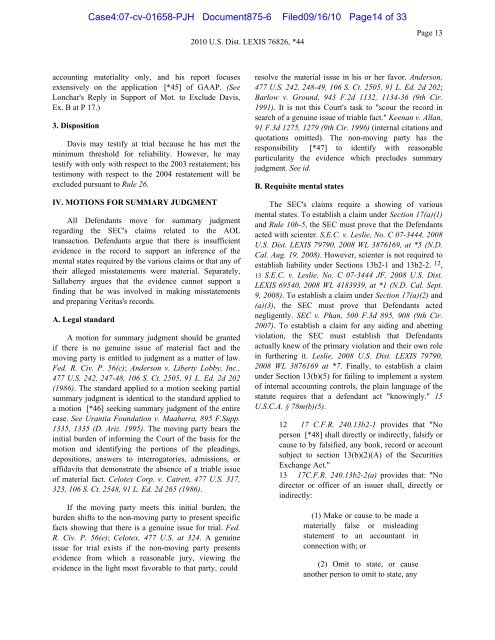exhibit 2 - SAP Lawsuit Portal
exhibit 2 - SAP Lawsuit Portal
exhibit 2 - SAP Lawsuit Portal
You also want an ePaper? Increase the reach of your titles
YUMPU automatically turns print PDFs into web optimized ePapers that Google loves.
accounting materiality only, and his report focuses<br />
extensively on the application [*45] of GAAP. (See<br />
Lonchar's Reply in Support of Mot. to Exclude Davis,<br />
Ex. B at P 17.)<br />
3. Disposition<br />
Davis may testify at trial because he has met the<br />
minimum threshold for reliability. However, he may<br />
testify with only with respect to the 2003 restatement; his<br />
testimony with respect to the 2004 restatement will be<br />
excluded pursuant to Rule 26.<br />
IV. MOTIONS FOR SUMMARY JUDGMENT<br />
All Defendants move for summary judgment<br />
regarding the SEC's claims related to the AOL<br />
transaction. Defendants argue that there is insufficient<br />
evidence in the record to support an inference of the<br />
mental states required by the various claims or that any of<br />
their alleged misstatements were material. Separately,<br />
Sallaberry argues that the evidence cannot support a<br />
finding that he was involved in making misstatements<br />
and preparing Veritas's records.<br />
A. Legal standard<br />
Case4:07-cv-01658-PJH Document875-6 Filed09/16/10 Page14 of 33<br />
A motion for summary judgment should be granted<br />
if there is no genuine issue of material fact and the<br />
moving party is entitled to judgment as a matter of law.<br />
Fed. R. Civ. P. 56(c); Anderson v. Liberty Lobby, Inc.,<br />
477 U.S. 242, 247-48, 106 S. Ct. 2505, 91 L. Ed. 2d 202<br />
(1986). The standard applied to a motion seeking partial<br />
summary judgment is identical to the standard applied to<br />
a motion [*46] seeking summary judgment of the entire<br />
case. See Urantia Foundation v. Maaherra, 895 F.Supp.<br />
1335, 1335 (D. Ariz. 1995). The moving party bears the<br />
initial burden of informing the Court of the basis for the<br />
motion and identifying the portions of the pleadings,<br />
depositions, answers to interrogatories, admissions, or<br />
affidavits that demonstrate the absence of a triable issue<br />
of material fact. Celotex Corp. v. Catrett, 477 U.S. 317,<br />
323, 106 S. Ct. 2548, 91 L. Ed. 2d 265 (1986).<br />
If the moving party meets this initial burden, the<br />
burden shifts to the non-moving party to present specific<br />
facts showing that there is a genuine issue for trial. Fed.<br />
R. Civ. P. 56(e); Celotex, 477 U.S. at 324. A genuine<br />
issue for trial exists if the non-moving party presents<br />
evidence from which a reasonable jury, viewing the<br />
evidence in the light most favorable to that party, could<br />
2010 U.S. Dist. LEXIS 76826, *44<br />
resolve the material issue in his or her favor. Anderson,<br />
477 U.S. 242, 248-49, 106 S. Ct. 2505, 91 L. Ed. 2d 202;<br />
Barlow v. Ground, 943 F.2d 1132, 1134-36 (9th Cir.<br />
1991). It is not this Court's task to "scour the record in<br />
search of a genuine issue of triable fact." Keenan v. Allan,<br />
91 F.3d 1275, 1279 (9th Cir. 1996) (internal citations and<br />
quotations omitted). The non-moving party has the<br />
responsibility [*47] to identify with reasonable<br />
particularity the evidence which precludes summary<br />
judgment. See id.<br />
B. Requisite mental states<br />
The SEC's claims require a showing of various<br />
mental states. To establish a claim under Section 17(a)(1)<br />
and Rule 10b-5, the SEC must prove that the Defendants<br />
acted with scienter. S.E.C. v. Leslie, No. C 07-3444, 2008<br />
U.S. Dist. LEXIS 79790, 2008 WL 3876169, at *5 (N.D.<br />
Cal. Aug. 19, 2008). However, scienter is not required to<br />
establish liability under Sections 13b2-1 and 13b2-2. 12 ,<br />
13 S.E.C. v. Leslie, No. C 07-3444 JF, 2008 U.S. Dist.<br />
LEXIS 69540, 2008 WL 4183939, at *1 (N.D. Cal. Sept.<br />
9, 2008). To establish a claim under Section 17(a)(2) and<br />
(a)(3), the SEC must prove that Defendants acted<br />
negligently. SEC v. Phan, 500 F.3d 895, 908 (9th Cir.<br />
2007). To establish a claim for any aiding and abetting<br />
violation, the SEC must establish that Defendants<br />
actually knew of the primary violation and their own role<br />
in furthering it. Leslie, 2008 U.S. Dist. LEXIS 79790,<br />
2008 WL 3876169 at *7. Finally, to establish a claim<br />
under Section 13(b)(5) for failing to implement a system<br />
of internal accounting controls, the plain language of the<br />
statute requires that a defendant act "knowingly." 15<br />
U.S.C.A. § 78m(b)(5).<br />
12 17 C.F.R. 240.13b2-1 provides that "No<br />
person [*48] shall directly or indirectly, falsify or<br />
cause to by falsified, any book, record or account<br />
subject to section 13(b)(2)(A) of the Securities<br />
Exchange Act."<br />
13 17C.F.R. 240.13b2-2(a) provides that: "No<br />
director or officer of an issuer shall, directly or<br />
indirectly:<br />
(1) Make or cause to be made a<br />
materially false or misleading<br />
statement to an accountant in<br />
connection with; or<br />
(2) Omit to state, or cause<br />
another person to omit to state, any<br />
Page 13


